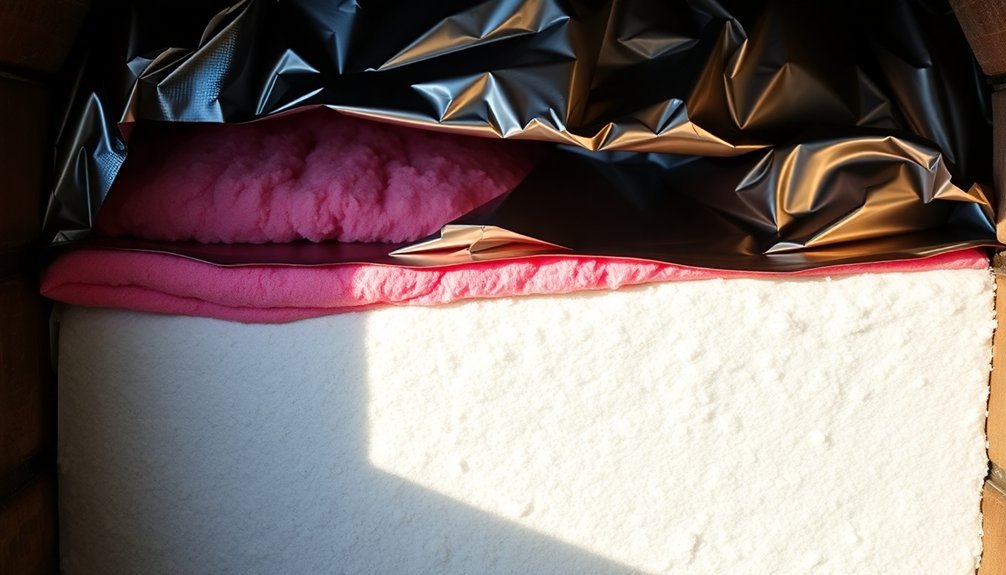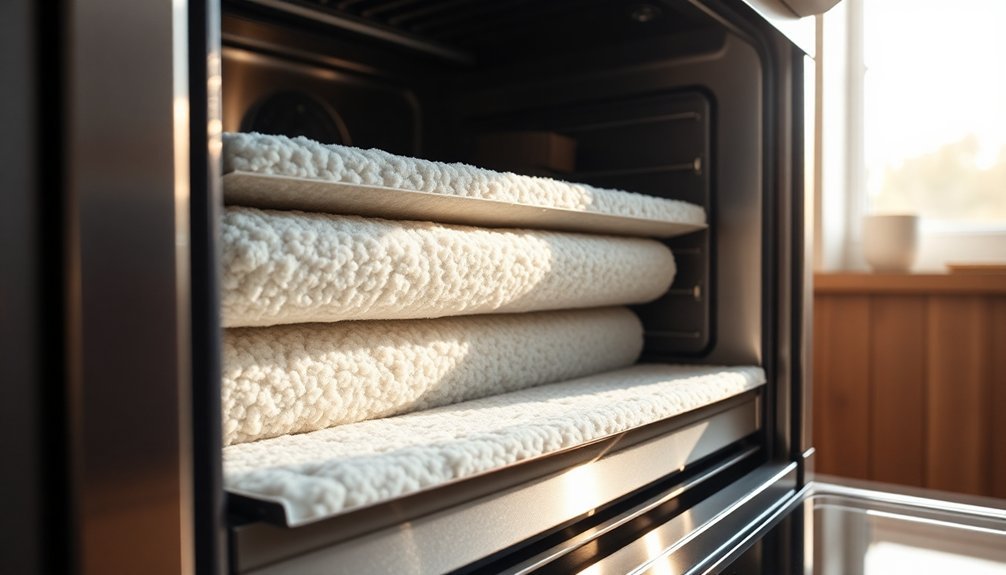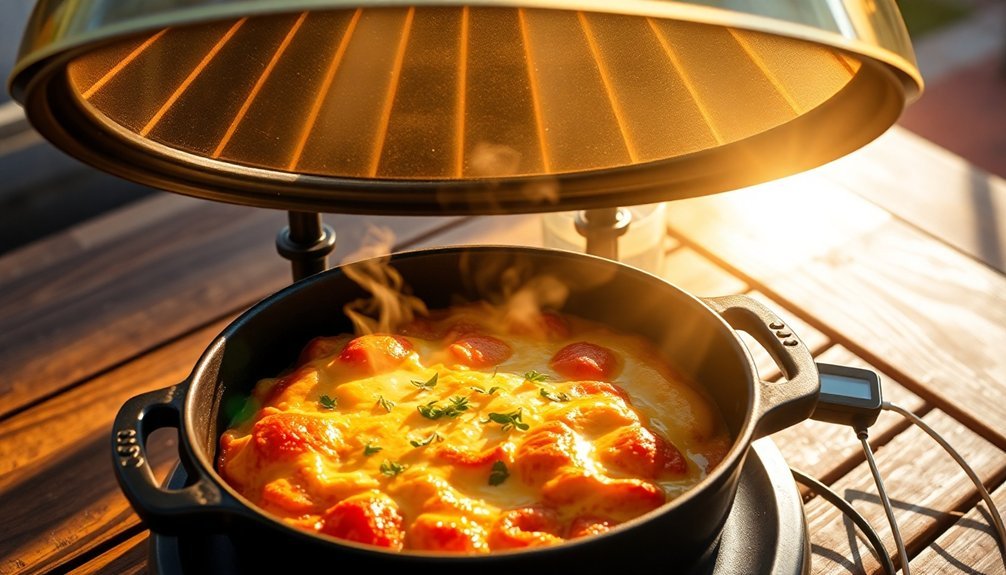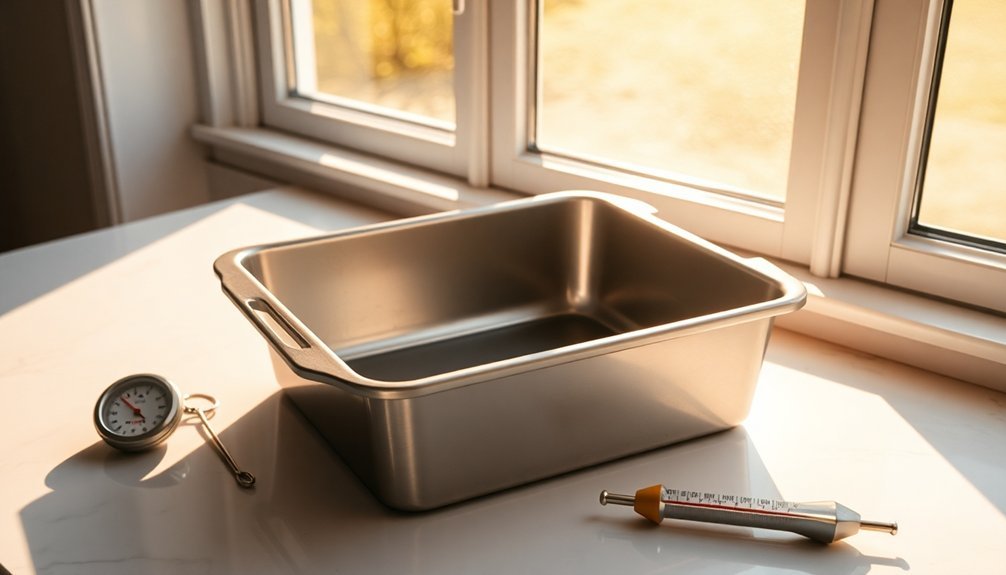Several key materials work together to keep your oven temperature steady. Fiberglass insulation, with its R-value of up to 3.8 per inch, helps trap heat effectively, while mineral wool can handle temperatures up to 1,400°F. You'll also want to think about thermal mass materials like bricks, stones, or dense ceramics, which stabilize temperatures by absorbing and slowly releasing heat. Modern ovens use PID controllers and electronic thermostats for precise control, while baking stones on the bottom rack help maintain even heating. For maximum temperature stability, you'll find sustainable options like cork insulation and recycled materials offer excellent performance too. Let's explore how these materials can transform your cooking experience.
Common Oven Insulation Materials

Oven insulation materials play a crucial role in maintaining consistent cooking temperatures and energy efficiency. Among the most common materials you'll find in modern ovens is fiberglass insulation, which offers an R-value of up to R-3.8 per inch and can withstand temperatures up to 550°C. It's particularly popular due to its cost-effectiveness and reliable thermal performance. The material works by trapping pockets of air to maintain desired cooking temperatures.
Mineral wool is another frequent choice, available in glass wool, rock wool, and slag wool varieties. You'll appreciate its non-combustible nature and ability to contain fires at temperatures up to 1,400°F.
For specialized applications, aerogel insulation provides superior performance, though at a higher cost, handling temperatures up to 2000°F with minimal heat transfer.
ISOVER glass wool has become increasingly popular in cooking ovens, combining sustainability with high thermal performance. It's manufactured using up to 80% recycled glass and can operate efficiently at temperatures up to 550°C.
When you're looking for spray-on solutions, Prosyneffex coatings offer a practical option, providing moisture-resistant insulation that's both durable and energy-efficient while maintaining safe-touch surfaces.
Heat Distribution Basics
From the moment heat enters your oven, three fundamental mechanisms work together to cook your food: conduction, convection, and radiation. Understanding these principles helps you achieve consistent cooking results and maintain steady temperatures in your oven.
Different oven types distribute heat uniquely. Conventional ovens use top and bottom heat sources, while convection ovens employ fans to circulate air for more uniform cooking. Fan forced ovens can achieve faster cooking times compared to conventional models. You'll need to adjust your cooking approach based on your oven type:
| Oven Type | Heat Distribution | Temperature Adjustment | Best For |
|---|---|---|---|
| Conventional | Top and bottom elements | Standard temperature | Traditional baking |
| Convection | Fan-forced circulation | Reduce by 25°F | Even browning |
| Radiation | All-metal surfaces | Standard temperature | Consistent heat |
| Combination | Multiple methods | Varies by setting | Versatile cooking |
To maintain steady temperatures, position your pans in the center of the oven and rotate them periodically. Use a reliable oven thermometer to monitor actual temperatures, as they can fluctuate from the set point. If you notice uneven cooking, consider using baking stones to stabilize temperature and reduce hot spots. For convection ovens, remember to lower the temperature by 25°F to prevent overcooking.
Thermal Mass Benefits

Managing steady oven temperatures becomes much easier when you understand thermal mass – a material's capacity to absorb, store, and release heat effectively. When you add thermal mass to your oven, you'll notice improved temperature stability and better heat recovery during baking.
The most effective thermal mass materials include brick, stone, and dense ceramics. You'll find that engineered refractory materials containing alumina and silica with calcium aluminate binder work particularly well, especially in thicknesses between 1.5 and 3 inches for home ovens.
However, don't add too much mass, as it can lead to excessive heat loss and slower heating times. Modern ovens with quick temperature recovery make thermal mass less crucial for maintaining stable temperatures.
You can easily incorporate thermal mass by using a baking stone on your oven's bottom rack. While it won't completely eliminate temperature fluctuations, it'll help moderate them and provide more even heating throughout your baking process.
For best results, you'll want to pair your thermal mass with proper insulation to prevent heat from escaping. Keep in mind that while thermal mass helps stabilize temperatures, it works best when combined with a well-calibrated oven and appropriate cooking techniques.
Efficient Temperature Control Systems
Inside modern ovens, efficient temperature control systems play a vital role in maintaining consistent heat levels. Your oven's temperature control system directly impacts cooking results and energy efficiency, with several options available to suit different needs and budgets.
You'll find advanced PID controllers offering the highest precision in temperature management, allowing you to maintain exact heat levels throughout the cooking process. These systems continuously monitor and adjust heating elements to prevent temperature fluctuations. Wireless sensors within the oven provide real-time temperature data for precise control.
If you're looking for user-friendly options, electronic thermostats provide digital feedback and programmable settings, making it easier to control your oven's temperature.
For a more budget-conscious approach, you can rely on mechanical thermostats, which offer durability and simplicity, though they're less precise than their digital counterparts.
Smart thermostats give you the added convenience of remote control and diagnostic capabilities through device integration.
If you're seeking a balance between cost and functionality, capillary thermostats use liquid-filled probes to regulate temperature effectively.
Regular maintenance of your chosen control system helps it continue to function at its best, aiding you in achieving consistent cooking results while maintaining energy efficiency.
Sustainable Material Choices

Sustainability shapes modern oven design through carefully selected materials that maintain temperature consistency while minimizing environmental impact. Cork insulation stands out as a top choice, serving as a natural carbon sink while providing excellent thermal resistance. You'll find this eco-friendly material especially effective at preventing heat loss and resisting moisture infiltration. Smart power management systems further enhance temperature control while reducing overall energy usage.
When you're looking at the oven's construction, recycled steel offers durability while reducing environmental impact. Combined with low-emission coatings, these materials create a sustainable foundation for temperature stability.
You can also consider alternative insulation options like sheep wool, which naturally resists fire and manages moisture, or cotton and denim insulation made from recycled materials.
Your oven's temperature consistency benefits from advanced sealing mechanisms that prevent heat escape. Natural fibers like hemp and bamboo provide additional insulation options, while cellulose derived from recycled paper products offers another green solution.
To maximize efficiency, modern sustainable ovens incorporate heat recovery systems that capture and reuse thermal energy. These design features work together with precise portion control mechanisms to reduce waste and maintain steady temperatures throughout the cooking process.
Frequently Asked Questions
How Often Should Oven Insulation Materials Be Replaced or Inspected?
You'll need to inspect your oven's insulation annually and replace it every 10-15 years. However, if you notice moisture damage, temperature fluctuations, or reduced efficiency, don't wait—replace it immediately.
Can Damaged Oven Insulation Affect Cooking Times and Energy Bills?
Yes, damaged oven insulation will definitely increase your cooking times and energy bills. You'll notice food takes longer to cook as heat escapes, and your oven works harder, consuming more power to maintain temperature.
What Causes Uneven Heating Despite Having Proper Insulation Materials?
Even with good insulation, you'll experience uneven heating if you have faulty heating elements, misaligned thermostats, or improper rack placement. Overcrowding your oven and inadequate preheating can also disrupt heat distribution.
Are There Warning Signs That Indicate Failing Oven Insulation?
You'll notice failing oven insulation through visible cracks, longer preheating times, uneven cooking, and hot exterior surfaces. Watch for unusual odors, increased energy bills, and discoloration of insulation materials as warning signs.
Does Altitude Affect How Well Different Insulation Materials Perform?
Yes, your insulation's performance changes with altitude. You'll notice reduced efficiency at higher elevations due to thinner air and lower pressure, requiring you to choose materials specifically designed for high-altitude conditions.
In Summary
You'll find that using the right combination of insulation materials and thermal mass elements makes a significant difference in your oven's temperature stability. Whether you're choosing fiberglass, ceramic fiber, or modern aerogels for insulation, pairing them with heat-distributing materials like stone or cast iron will help maintain steady temperatures. Consider upgrading your oven's control systems and selecting eco-friendly materials for ideal performance and sustainability.





Leave a Reply